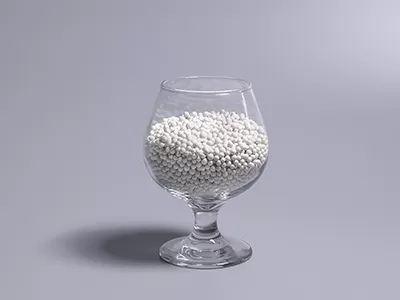Activated alumina, also known as activated alumina beads, is a material with high adsorption capacity, thermal stability and chemical stability.
It is made from aluminate or aluminium hydroxide as raw materials and is formed into tiny spherical particles under high-temperature conditions. The porosity of these particles is over 40%.
Activated alumina has broad application prospects in the fields of environmental protection, energy, and the chemical industry.
The preparation methods of active alumina mainly include two types: physical methods and chemical methods.
Physical method: By using high temperature, high pressure and high-speed rotation, the aluminum oxide or aluminum hydroxide particles are transformed into spherical particles under specific conditions.
The activated alumina prepared by the physical method has the advantages of uniform particle size distribution and smooth surface.

Chemical method: Using methods such as sol-gel method, hydrothermal method, and co-precipitation method, spherical particles can be obtained through chemical reactions.
1. The activated alumina prepared by the chemical method has the advantages of a more complete pore structure and a more uniform pore size distribution.
2. Properties of Active Aluminum Oxide
The active alumina has a high specific surface area and porosity, and there are a large number of oxygen vacancies on its surface, which makes it have strong adsorption and catalytic properties.
Meanwhile, the activated alumina also possesses excellent high-temperature resistance and chemical stability, and is not easily eroded by water, acids, alkalis and other chemical substances.
Therefore, activated alumina has broad application prospects in areas such as adsorption, catalysis, and separation.

3. Applications of Active Aluminum Oxide
(1) Adsorption materials: Activated alumina has excellent adsorption properties and can be used in fields such as air purification, water treatment, and waste gas treatment.
For instance, using activated alumina as an adsorbent for waste gas treatment can effectively remove harmful gases such as sulfur dioxide and nitrogen oxides.
(2) Catalyst carrier: Activated alumina is used as the catalyst carrier, which can enhance the catalytic activity and selectivity of the catalyst.
For instance, in the petrochemical industry, activated alumina is often used as a catalyst carrier, being employed in reactions such as hydrogenation, dehydrogenation, and cracking.
(3) Separation material: Activated alumina has a high specific surface area and porosity, and can be used for the preparation of separation materials.
For instance, using activated alumina as a separation material can significantly enhance the efficiency and selectivity of separating organic substances.
| Parameter | Properties of special oxidized aluminum for hydrogen peroxide | Properties of Active Aluminum Oxide Desiccant | Active alumina fluoride remover |
| Crystalline phase | γ-Al2O3 | x-ρ Al2O3 | |
| Dimension(mm) | 7~14mesh Φ3~5、Φ4~6 、Φ5~7 | Φ3~5、Φ4~6、Φ5~7 、Φ8-10 | Φ1.5~2、Φ4~3、Φ4~6 、Φ5~7 |
| appearance | White spherical shape | White spherical shape | White spherical shape |
| Density (g/cm3) | 0.68-0.75 | 0.68~0.89 | ≥0.75 |
| Strength(N/粒) | >50 | >130 | 50~80 |
| Specific Surface Area(m2/g) | 200~260 | 280~360 | 280~360 |
| Pore Volume(cm3/g) | 0.40~0.46 | 0.38~0.40 | 0.4 |
| Big Pore(>750A) | 0.14 | ||
| water absorption (%) | >50 | ||
| Static adsorption capacity (RH%) | 18 | ||
| Except for fluorine (mgF/g Al2O3) | ≥1.2 |


.jpg)
.jpg)
.jpg)
.jpg)